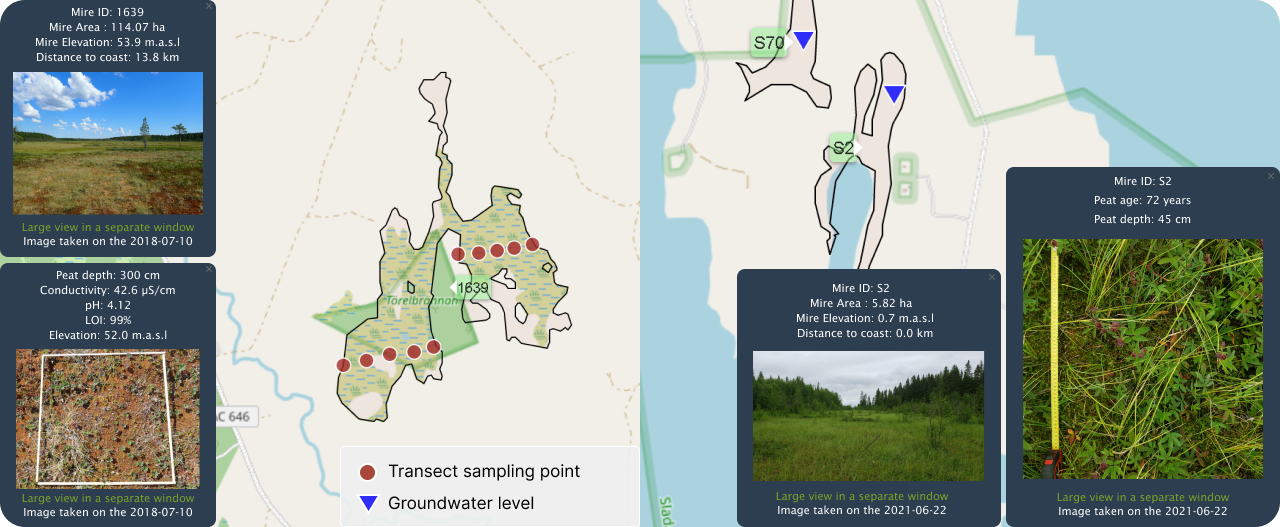Sävar Rising Coastline Mire Chronosequence
Background
The Sävar Rising Coastline Mire Chronosequence (SMC) is a study area in the Swedish province of Västerbotten in the Bothnian Bay Lowlands (BBL), located ~ 20 km northeast of the town Umeå. The young boreal landscape is characterized by post-glacial isostatic rebound, today at a rate of ~ 9 mm per year. Since the onset of the last deglaciation, new land areas have continuously been exposed from the sea, constantly offering new locales suitable for primary mire formation. As a result, a natural mire chronosequence has formed between the present coastline (0 years BP) and the highest coastline (~ 10 000 years BP), with increasing mire ages the further inland from the present coast the mire is found. The strong age gradient implies similar present climatic conditions across the area and provides a unique opportunity to study mire succession at the landscape level.
Interactive map
In the interactive map, field photos from two separate transects in the Sävar Rising Coastline Mire Chronosequence (SMC) are included. The mires are searchable using their unique IDs. From the legend box, the background map can be set to street, topographic, terrain or satellite view. When you click on a mire shape, a landscape photo along with mire geographical properties are displayed and when you click on a point a vegetation photo is displayed along with sampling point data.
In 57 chronosequence mires, edge-to-edge sampling transects have been applied (red points in the map). Between one and four sampling transects, with five sampling points each, are used to cover within-mire variation in peat properties. In total 400 sampling points were distributed across the 57 mires, and visited during July and August 2018. In the vegetation photos, a 50 x 50 cm frame is used. ...
In 15 chronosequence mires (marked with blue triangles), relative and absolute groundwater levels have been continuously monitored for two years (2021-2023). The groundwater monitored mires have been used in several studies describing among others mercury dynamics (Hu et al., 2020; Wang et al., 2023, 2021, 2020) and plant succession (Laine et al., 2021).
References to studies from the mire chronosequence:
Ehnvall, B., Ratcliffe, J. L., Nilsson, M. B., Öquist, M. G., Sponseller, R. A., & Grabs, T., 2024. Topography and Time Shape Mire Morphometry and Large‐Scale Mire Distribution Patterns in the Northern Boreal Landscape. Journal of Geophysical Research: Earth Surface, 129(2) https://doi.org/10.1029/2023JF007324
Ehnvall, B., 2023. Catchment controls on mire properties in the post-glacial landscape. Acta Universitatis Agriculturae Sueciae (2023: 73) https://doi.org/10.54612/a.2hq3ebpddu
Ehnvall, B., Ågren, A.M., Nilsson, M.B., Ratcliffe, J.L., Noumonvi, K.D., Peichl, M., Lidberg, W., Giesler, R., Mörth, C.-M., Öquist, M.G., 2023. Catchment characteristics control boreal mire nutrient regime and vegetation patterns over ~5000 years of landscape development. Sci. Total Environ. 165132. https://doi.org/10.1016/j.scitotenv.2023.165132
Ehnvall, B., Ratcliffe, J.L., Bohlin, E., Nilsson, M.B., Öquist, M.G., Sponseller, R.A., Grabs, T., 2023. Landscape constraints on mire lateral expansion. Quat. Sci. Rev. 302, 107961. https://doi.org/10.1016/j.quascirev.2023.107961
Hu, H., Wang, B., Bravo, A.G., Björn, E., Skyllberg, U., Amouroux, D., Tessier, E., Zopfi, J., Feng, X., Bishop, K., Nilsson, M.B., Bertilsson, S., 2020. Shifts in mercury methylation across a peatland chronosequence: From sulfate reduction to methanogenesis and syntrophy. J. Hazard. Mater. 387, 121967. https://doi.org/10.1016/j.jhazmat.2019.121967
Laine, A.M., Lindholm, T., Nilsson, M., Kutznetsov, O., Jassey, V.E.J., Tuittila, E., 2021. Functional diversity and trait composition of vascular plant and Sphagnum moss communities during peatland succession across land uplift regions. J. Ecol. 109, 1774–1789. https://doi.org/10.1111/1365-2745.13601
Smeds, J., Öquist, M., Nilsson, M.B., Bishop, K., 2022. Smeds, J., Öquist, M., Nilsson, M.B., Bishop, K., 2022. A Simplified Drying Procedure for Analysing Hg Concentrations. Water. Air. Soil Pollut. 233, 216. https://doi.org/10.1007/s11270-022-05678-7
Wang, B., Hu, H., Bishop, K., Buck, M., Björn, E., Skyllberg, U., Nilsson, M.B., Bertilsson, S., Bravo, A.G., 2023. Microbial communities mediating net methylmercury formation along a trophic gradient in a peatland chronosequence. J. Hazard. Mater. 442, 130057. https://doi.org/10.1016/j.jhazmat.2022.130057
Wang, B., Nilsson, M.B., Eklöf, K., Hu, H., Ehnvall, B., Bravo, A.G., Zhong, S., Åkeblom, S., Björn, E., Bertilsson, S., Skyllberg, U., Bishop, K., 2020. Opposing spatial trends in methylmercury and total mercury along a peatland chronosequence trophic gradient. Sci. Total Environ. 718, 137306. https://doi.org/10.1016/j.scitotenv.2020.137306
Wang, B., Zhong, S., Bishop, K., Nilsson, M.B., Hu, H., Eklöf, K., Bravo, A.G., Åkerblom, S., Bertilsson, S., Björn, E., Skyllberg, U., 2021. Biogeochemical influences on net methylmercury formation proxies along a peatland chronosequence. Geochim. Cosmochim. Acta 308, 188–203. https://doi.org/10.1016/j.gca.2021.06.010
